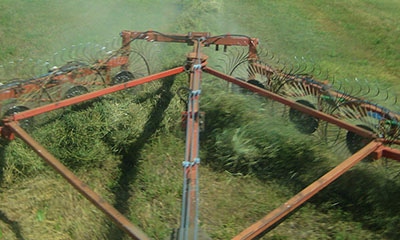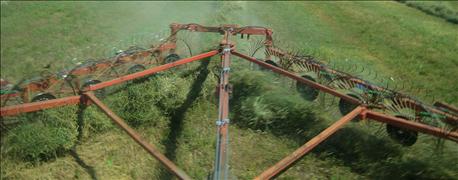
Most dairy producers check crude protein and fiber content (neutral detergent fiber) before feeding hay and haylage. But how about ash content – dust and dirt?
If you clipped hay close to the ground to harvest maximum tonnage or raised a cloud of dust while raking tedding, baling or chopping check that forage's ash content, advises Dan Undersander, Extension forage agronomist at University of Wisconsin. Grasses normally have 4% to 6% ash content while alfalfa and clover typically contains 6% to 8%.

RAKE TO THE MIDDLE: Undersander suggests moving two outside swaths onto a middle swath is better than raking all three to one side.
But dust and dirt can spike ash content. Each 1% ash means 1% less total digestible nutrients. Ash content of forages submitted to University of Wisconsin's Forage Testing Laboratory average about 12.3%.
That's similar to samples tested by Cornell University. That means those haylages contain 4% to 6% dirt. High-testing samples contain about 18% ash. It's like feeding 1 pound of dirt for every 4 pounds of hay.
So check your forages, urges Understander. At $150 to $200 a ton, you're losing $15 to $20 for 10% ash plus another $2 per ton for each percent above 10%. And keep your cutting height at 2.5 to 3 inches
Cutting the dirt
Undersander also explored why it happens and how different harvest equipment impacts hay dirt and feed quality. Consider these facts:
* Mower knives that "pick up hay" better will also pick up more dirt.
* While lower cutting heights increase yield about 0.5 tons per acre per year for each inch, it reduces forage quality by 5 points of relative feed value per inch.
* Compared to rotary rakes, wheel rakes tend to raise potential ash content higher.
* Mergers result in less ash on forages than rakes.
About the Author(s)
You May Also Like




